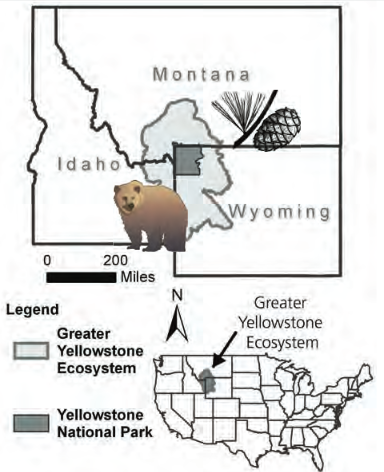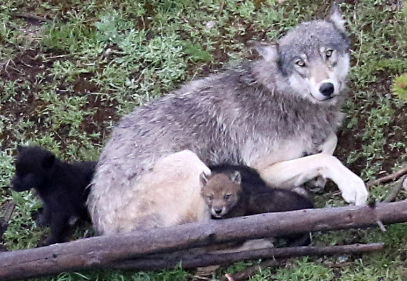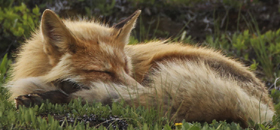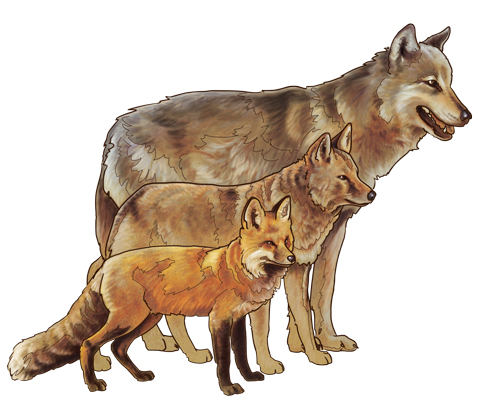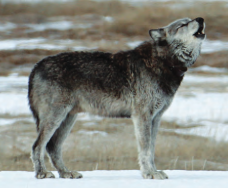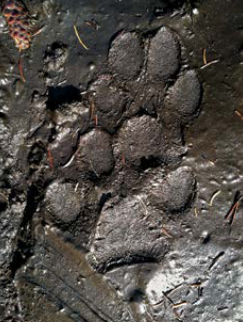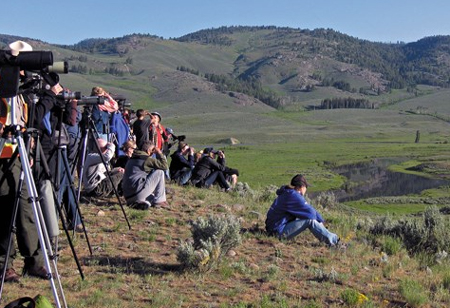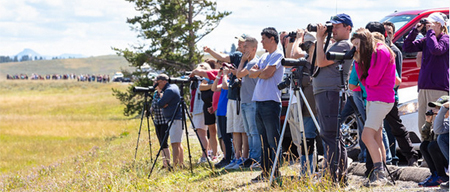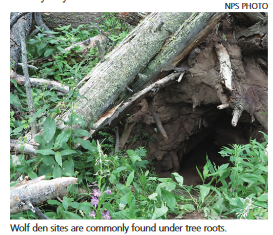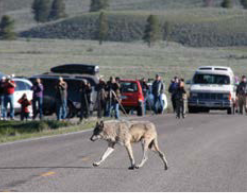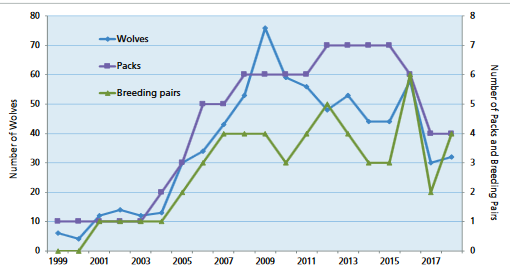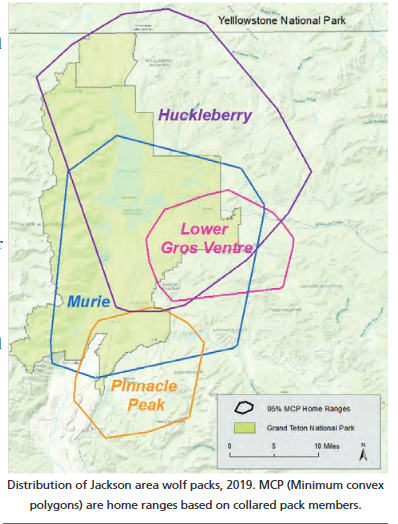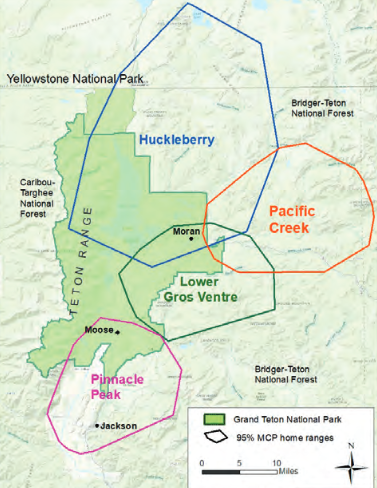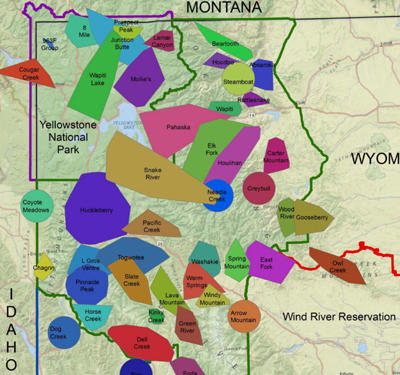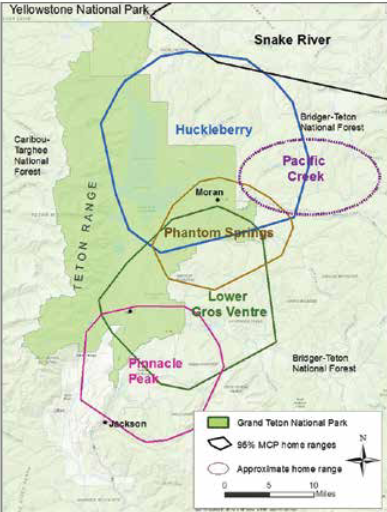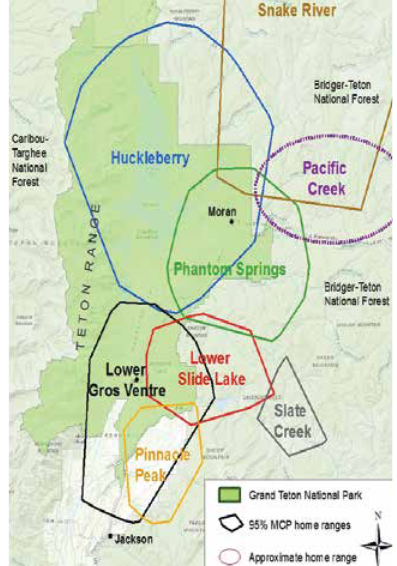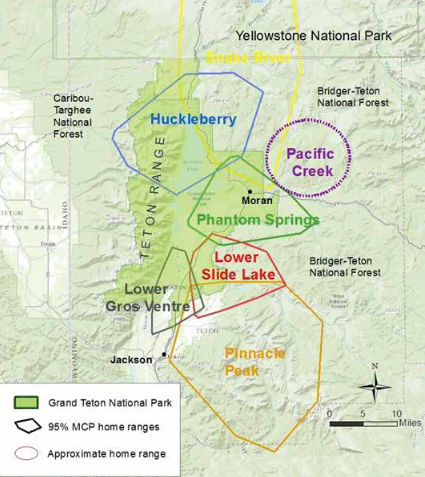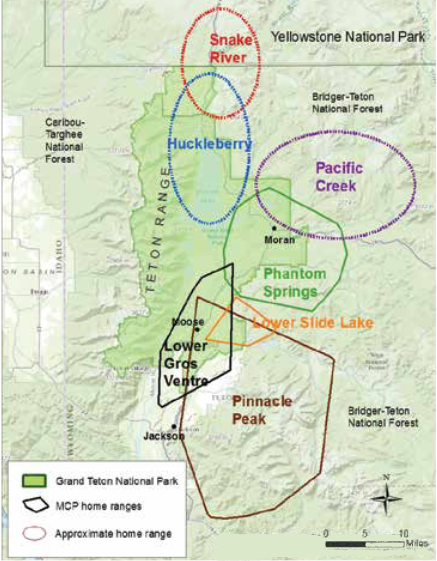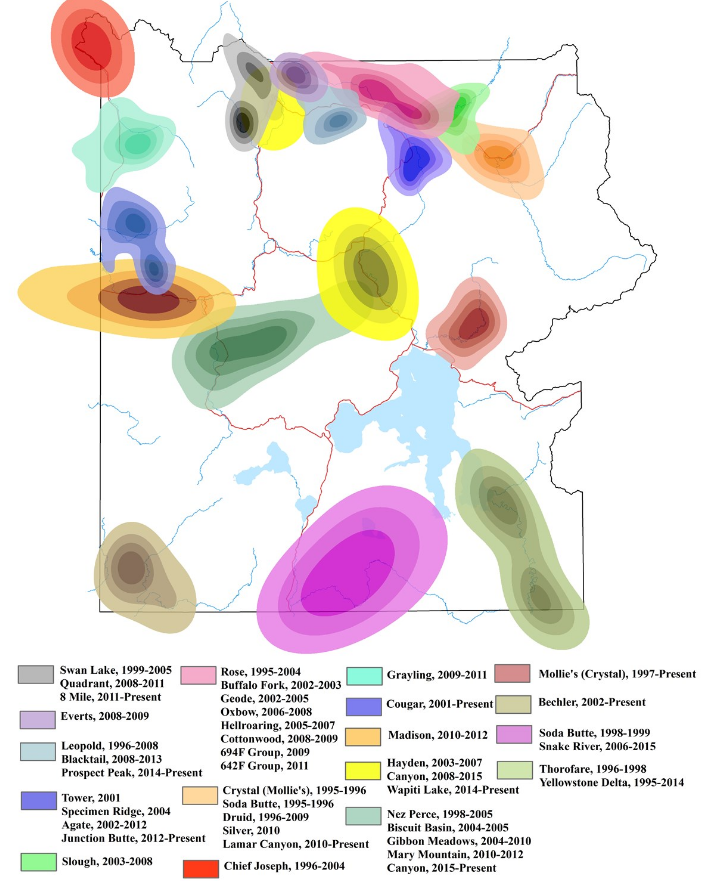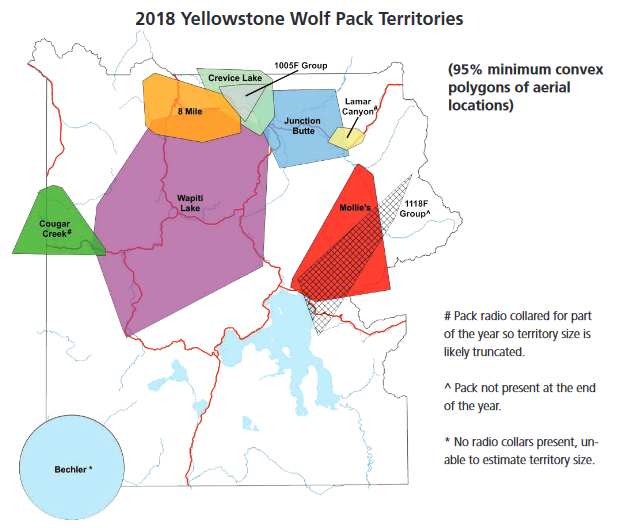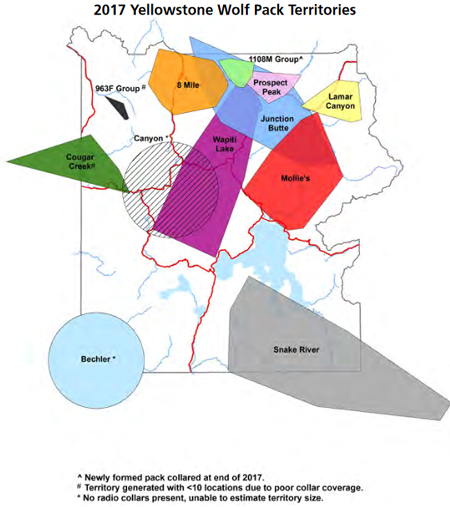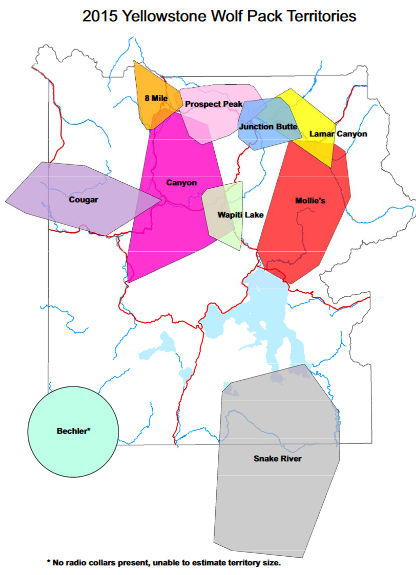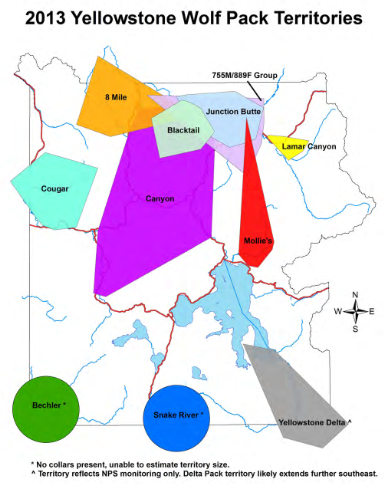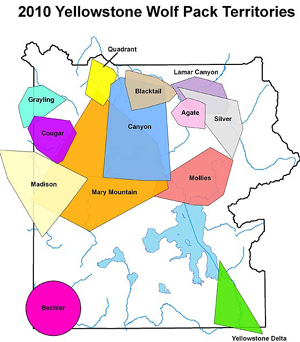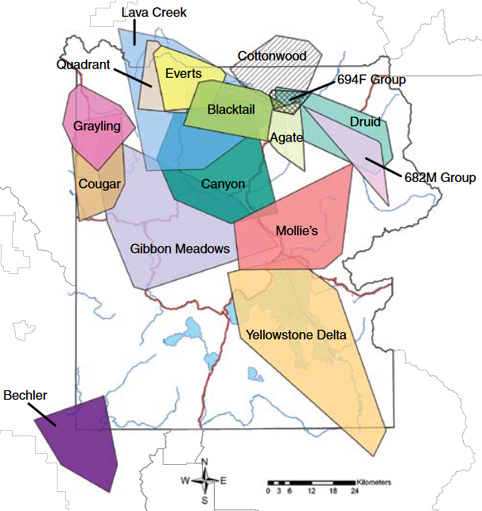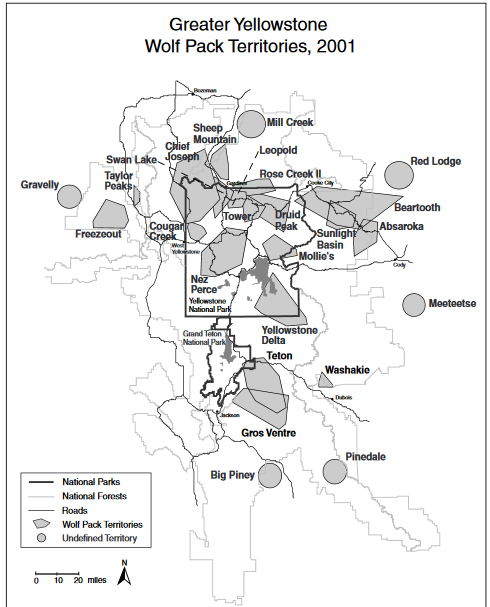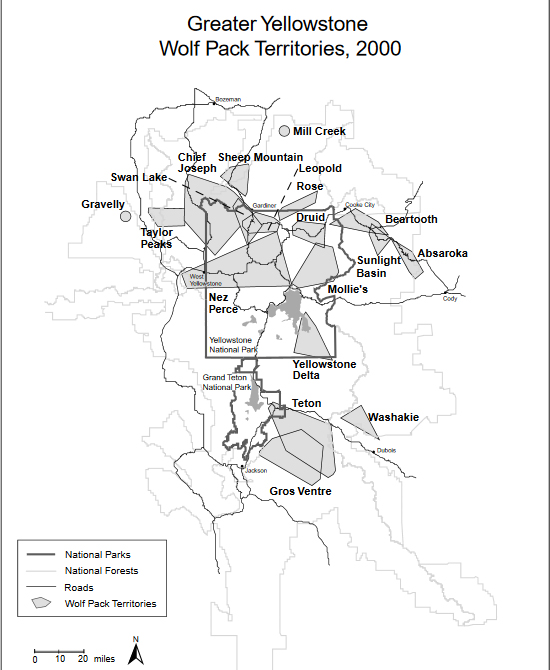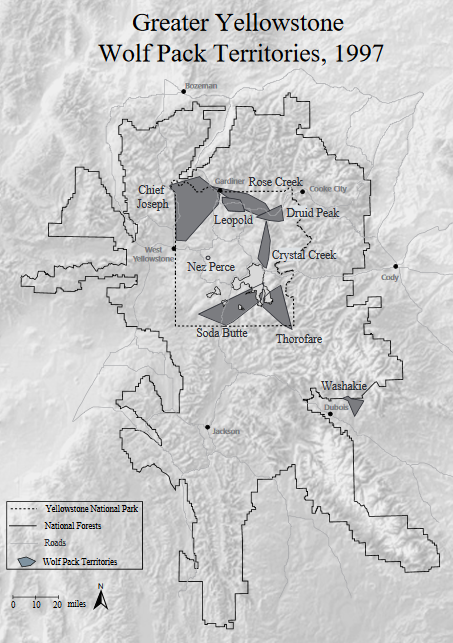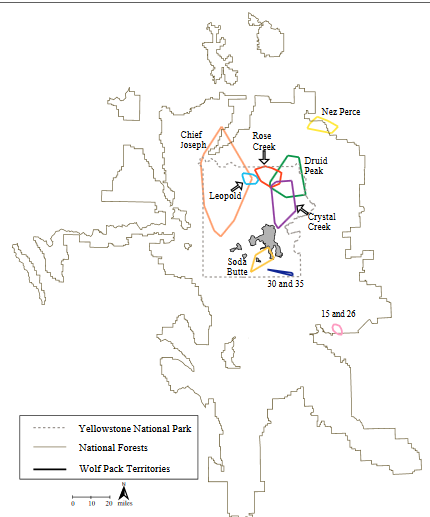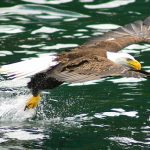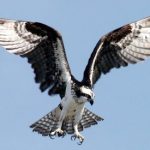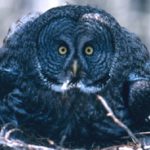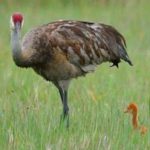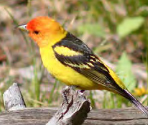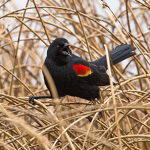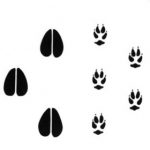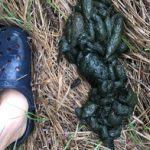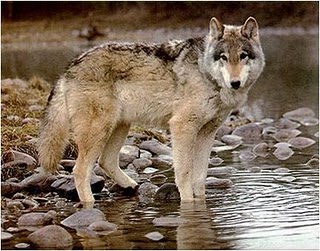
Some of the surveys / charts / maps below of the territories of wolf packs are of
Grand Teton National Park (some not only Grand Teton National Park, but the whole Jackson area, including Bridger-Teton National Forest to the east of the park and Caribou-Targhee National Forest to the west of the park),
some are of Yellowstone National Park and some are of both parks as included in the Greater Yellowstone Ecosystem (Greater Yellowstone Area). In the map below Yellowstone park is in the center, the Greater Yellowstone Ecosystem surrounds the park and stretches out into Idaho, Montana and Wyoming:
Some wolf pack charts are one year, some as many as 20 years.
(There are also individual wolves not currently affiliated with a pack at the time each survey was completed, and not shown on the chart / map.)
The Yellowstone National Park yearly wolf reports, (linked to below at each of the maps), including numbers of and details about wolves in each pack, territory changes, births and notes about wolf interactions with bears, Ravens, Magpies, coyotes, bison and elk.
The main Yellowstone National park webpage about wolves is
https://www.nps.gov/yell/learn/nature/wolves.htm
According to Yellowstone Forever, as of 2021
“31 wolves were reintroduced to Yellowstone National Park between 1995 and 1997, and today, at least 94 wolves in 8 unique packs thrive in the park”
https://www.yellowstone.org/
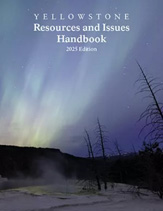 In the Yellowstone Resources and Issues Handbook “As of January 2025, at least 108 live primarily in the park.” https://www.nps.gov/yell/learn/resources-and-issues.htm
In the Yellowstone Resources and Issues Handbook “As of January 2025, at least 108 live primarily in the park.” https://www.nps.gov/yell/learn/resources-and-issues.htm
___________________________________
___________________________________
Below a NPS drawing showing the size comparison of a wolf, coyote and a fox.

A wolf, up to 35″ tall, is much bigger than a coyote or family dog, but it can be hard to tell at a distance, which is where you will most likely see one if at all. Wolves can weight 70-120 pounds, coyotes only 25-40.
Wolves run on the average 5 mph, or up to 35 mph.
Wolves can be coal black, creamy white and everything (gray, tan) in between.
Coyotes are gray, tawny, buffy or reddish gray, with some orange on its tail and ears.
On a Yellowstone trip we watched a coyote sniffing at the tracks in the snow. A coyote’s long nose is full of scent receptors and can detect the movement of other animals a mile or more away or days earlier.

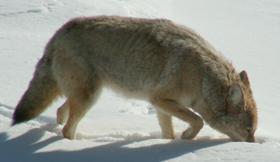
The coyote often holds his tail between his legs when running. His nose is more pointed than a wolf.
The coyotes have a narrow, triangular shaped head. A wolf has a more square, blocky head.
A red fox has red fur with white-tipped tail, dark legs; long, slender snout. It has a bushier tail than a coyote. Some are black or silver.
Adult males weigh 11–12 pounds; females weigh average 10 pounds.
Average 43 inches long.
A National Park Service drawing comparing the size and coloration of a fox (front), coyote (center), and wolf (back), by Michael Warner from a Yellowstone Park webpage
A red fox barks, but rarely howls/sings.
Wolves and coyotes both sing long howls, but the wolf does not add yips/yaps.
Yellowstone park notes that that wolves howl for “intrapack communication, advertising territory, coordinating social activities.”
In https://www.nps.gov/yell/learn/ys-24-1-why-wolves-howl.htm we read:
“. . . wolves have an amazing ability to distinguish differences in harmonic overtones in each other’s howls, which makes individual recognition possible from a distance . . . identified structural differences in the fundamental frequencies of the howls of different wolves. We also learned that a higher level of excitement is reflected in higher pitched vocalizations . . . ”
Denali park notes that “Wolves are noted for their distinctive howl, which they use as a form of communication. Biologists do not know all of the reasons why wolves howl, but they may do so before and after a hunt, to sound an alarm, and to locate other members of the pack when separated. Wolves howl more frequently in the evening and early morning, especially during winter breeding and pup rearing. Howling is also one way that packs warn other wolves to stay out of their territory.”
https://www.nps.gov/articles/why-wolves-howl.htm
What wolf or wolves howling sounds like:
https://www.nps.gov/yell/learn/photosmultimedia/sounds-wolves.htm
Yellowstone park notes: DISTANCE HOWLING CAN BE HEARD:
forest = 11km (6.6 mi), open areas = 16 km (9.6 mi)
First photo below of mollie’s wolfpack in Yellowstone: (in social situations like the first photo, the height the tail is carried generally relates to the social status of that wolf).

![]()
AVERAGE LIFE SPAN (Yellowstone National Park): 4-5 years
AVERAGE LIFE SPAN (OUTSIDE Yellowstone National Park): estimated 2-3 years
(Some live to be 14 years old.)
The International Wolf Center tells us that “The biting capacity of a wolf is 1,000 to 1,500 pounds of pressure per square inch… In comparison, a German Shepard has a biting pressure of 750 pounds per square inch. A human has a much lower biting pressure of 300 pounds per square inch.”
NPS photo of wolf tracks in mud:
Coyote front prints are usually 2 3/4 inches in length or less, some large dog breeds can have prints as big as a wolf, wolves are usually 3 1/2 inches or more in length not including the claws.
If you measure your palm before you go on a trip, you can use it to “size” a track you might see. A wolf track will be bigger than coyote, which is bigger than a fox, but an adult fox print might be the same size as a wolf pup. Tracks can be slightly different sizes / shapes in soft mud (especially after recent rain) or melting snow.
wolf track in snow: 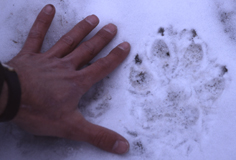
coyote has a walking stride of 6 to 8 inches and leaps of 10 feet,
wolf has a walking stride of nearly 30 inches and leaps of 9 or more feet
Wolves run an average of 5 m.p.h., as fast as 35 m.p.h.

Was that a wolf or a coyote? An elk or a moose?
 Rocky Mountain mammal size comparisons
Rocky Mountain mammal size comparisons 
Rocky Mountain mammal size comparisons has photos and comparisons of beavers, squirrels, pika, marmot, elk, moose, bison, fox, coyote, wolf, golden-mantled ground squirrel, chipmunk, Red Squirrel (also known as) Chickaree, Unita Ground squirrels, bobcat, lynx, mountain lion (cougar), pine marten, mountain goats, bighorn sheep, pronghorn, grizzly and black bears, tundra swan, trumpeter swan, adult and juvenile Bald Eagles.
When wolves move through deep snow they often go single file, with adults breaking trail through the snow for the younger / smaller wolves.
Below, the shadows are quite large compared to the wolves:
The text to go with this NPS photo said: “The 8 Mile Pack tangles with a grizzly bear in classic fashion. Bears can easily overpower a wolf if they can catch them. The to and fro is on display here with wolves harassing and outnumbering a bear in a contest over a carcass in a mudhole. The bear resorts to jumping in with the carcass.”
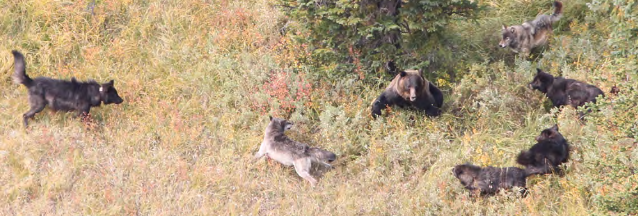
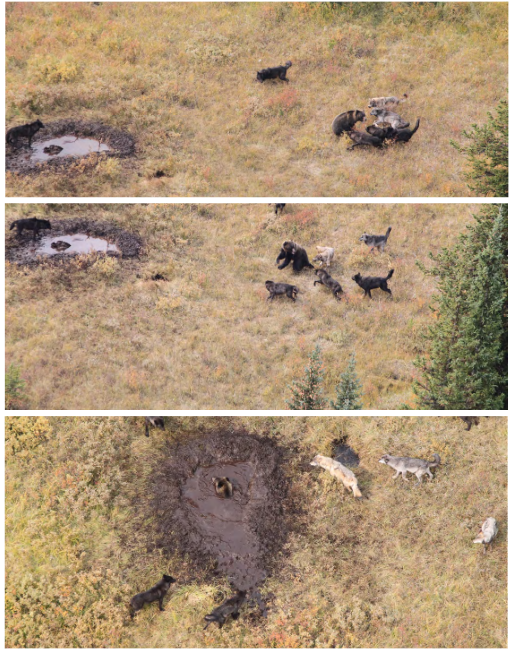
Wolf watching tips:
The Lamar Valley has been a wolf watching mecca since the wolves were reintroduced in 1995.
Yellowstone National Park notes:
“While all of Yellowstone offers chances for great wildlife sightings and photography, the highest concentration of animals can usually be found along the Yellowstone and Lamar river valleys between Mammoth Hot Springs and the Northeast Entrance.” (The start of the only road open in the winter.)
“. . . Winter is best since snow makes the wolves easier to see.”
The Slough Creek area in northern Yellowstone is said to be the best place to watch wolves and it attracts many people all year.
Sometimes there are so many people that the wolves have difficulty just crossing a road. One wolf parent had to go five miles away from his usual route when trying to bring food back to pups in the den, because people kept moving along the roadside, trying to get a photo, and blocked his safe route to get through them across the road.
We have let strangers use our spotter scope when we have it set up to watch wildlife. Please take this advice, if you let people look through a device / camera on your tripod, tell them you can adjust the height of it for them and ask them to not touch it, BUT also keep one hand on the tripod the entire time you share it. (Children and even some adults do not seem to understand that if it is moved even slightly, you will lose sight of the animal you wanted to see AND you risk even careful people knocking it over.)
Yellowstone Forever, the official nonprofit partner of Yellowstone National Park, offers many wolf watching trips, including with guides, transportation and overnight accommodations in the park.
https://www.yellowstone.org/experience/yellowstone-forever-institute/
When you buy wildlife guides, maps, books from them the profit goes to the park. https://shop.yellowstone.org/
On a winter trip we took we found that if you stand on sections of insulating sleeping pads it helps keep your feet less cold.
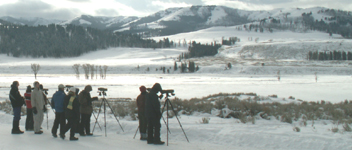
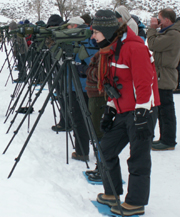
And if you have a small bag hanging around your neck, or around your waist inside your sweaters and jackets you can keep spare sets of camera batteries in it to keep them warm, as the batteries in the cameras weakened in the cold and needed to be switched around regularly.
The park says “peak activity is at dawn and dusk” but we watched all day. Well across the Lamar Valley we could see a live nature video unfold with tiny animals in the distance from the naked eye, animals clearly visible through binoculars and quite close up through spotting scopes.
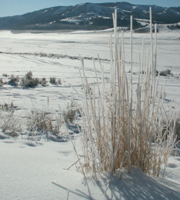
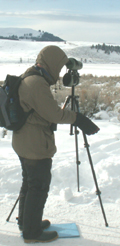
The folding or pop-up chair for sitting at the campfire and sitting while waiting for wolves to appear,
will be much more comfortable (you’ll be noticeably warmer)
with a foam/ensolite pad / sleeping size pad lining it,
as in the chair on the left in the photo below:
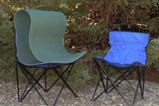
See also snow or rain camping equipment for details about choosing warm gloves / clothes and rain gear that actually functions.
The park service makes wolf den sites off-limits, with signage and usually with notices at park websites.
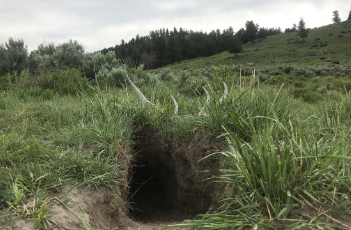
Your safety while wildlife watching
For your safety while wildlife viewing, stay 25 yards away, at least, for most wildlife, and 100 yards for bears, moose, elk, bison and wolves, whether on foot or in your car.
Keep the animal’s line of travel or escape route clear and move away if wildlife approaches you.
How far away is 100 yards? Picture the length of a football field without the end zones.
25 yards? picture four car lengths or six kayak lengths, or the width of an Olympic-sized pool like ours at the college.
If you have an accidental, surprise or inadvertent closer encounter with wildlife you must remove yourself to those distances,
including while driving on a road. (more on wildlife jams)
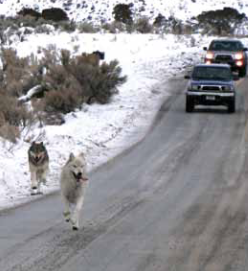
<a
Grand Canyon National Park rangers say: “Follow the rule of thumb: if you can cover the entire wild animal with your thumb you’re at a safe distance. This distance is usually 25 yards from most wildlife and 100 yards from large wildlife . . .
If you are close enough to take a selfie with an animal, you are too close. ”
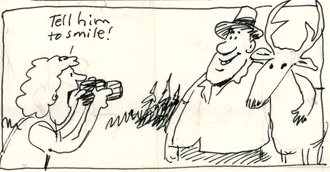
They were just taking a selfie…
More on determining safe distances from wildlife, with charts and photos to better be able to determine and visualize how far away from wildlife you need to stay to be safe (and obey laws that do have penalties).
Yellowstone National park had this in the Yellowstone Visitor Guide:

Yellowstone Park has this advice: “Your Safety in Wolf Country
Wolves are not normally a danger to humans, unless humans habituate them by providing them with food. No wolf has attacked a human in Yellowstone, but a few attacks have occurred in other places.
Like coyotes, wolves can quickly learn to associate campgrounds, picnic areas, and roads with food. This can lead to aggressive behavior toward humans.
What You Can Do
• Never feed a wolf or any other wildlife. Do not leave food or garbage outside unattended. Make sure the door is shut on a garbage can or dumpster after you deposit a bag of trash.
• Treat wolves with the same respect you give any other wild animal. If you see a wolf, do not approach it.
• Never leave small children unattended.
• If you have a dog, keep it leashed.
• If you are concerned about a wolf—it’s too close, or is not showing sufficient fear of humans— do not run. Stop, stand tall, and watch what the wolf does. If it approaches, wave your arms, yell, flare your jacket. If it continues, throw something at it or use bear pepper spray. Group up with other people, and continue waving and yelling.
• Report the presence of wolves near developed areas or any wolf behaving strangely.
To date, eight wolves in Yellowstone National Park have become habituated to humans. Biologists successfully conducted aversive conditioning on some of them to discourage being close to humans, but two had to be killed.
. . . If you are concerned about a wolf — it’s too close, or is not showing sufficient fear of humans — do not run. Stop, stand tall, and watch what the wolf does. If it approaches, wave your arms, yell, flare your jacket. If it continues, throw something at it or use bear pepper spray. Group up with other people, and continue waving and yelling.”
Yellowstone National Park offers video on how to use bear spray

Teton Science School gives us this answer:
Wolves: Lamar valley
Grizzly bears : Hayden Valley or Lamar Valley are equally good.
Birds: “For bird photography, Lamar has a slight edge over Hayden during nesting season, but for the real bird-nerds, head to Hayden Valley.”
Bison: “For sheer year-round numbers and just a teasing hint at the rich bison-covered plains seen by Lewis and Clark, the win goes to Lamar.”
Moose: “There is almost no moose food in Hayden Valley – no willows or cottonwoods along the river, no aspens on the hillside. Lamar Valley has seen an increase in moose sightings over the last decade as the deciduous trees and shrubs grow back after decades of overbrowsing by overpopulated elk. Moose are one of the most heat-sensitive animals in the Park, so look for moose early in the morning or on cold rainy days.”
Elk: Lamar
Lamar Valley . . . “is home to bighorn sheep, pronghorn (in the snow-free months), deer, and the non-native mountain goat”

(All wolves currently living in Yellowstone were born in the park.) The story of how wolves were re-introduced into Yellowstone park from Canada is at:
https://www.nps.gov/yell/learn/nature/wolf-restoration.htm
NPS map Historical and current range of gray wolves in the United States and Canada:
Celebrating 20 years of wolves
https://www.nps.gov/yell/learn/upload/YELLOWSTONE-SCIENCE-24-1-WOLVES.pdf
___________________________________
___________________________________
Grand Teton National Park yearly wolf pack territories:
NPS chart of the Population growth of Jackson area wolves, including those in Grand Teton NP, 1999-2018.
NPS chart of the Population growth of Jackson area wolves, including those in Grand Teton NP, 1998-2015.
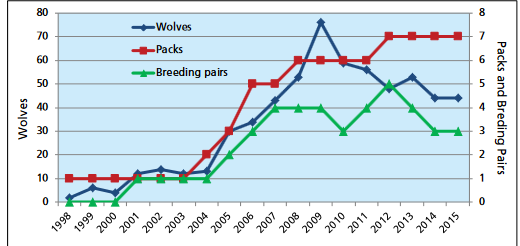
A Grand Teton Park 2024 annual report said there were 49 wolves in five packs in the park.
https://www.nps.gov/grte/learn/management/upload/GRTE_GrandGlimpse2024_Web_508.pdf
A Grand Teton Park 2023 annual report said there were 40 wolves in five packs in the park.
https://www.nps.gov/grte/upload/Grand-Teton-2023-Annual-Report.pdf
2023 wolf pack territories in and around Grand Teton National Park:
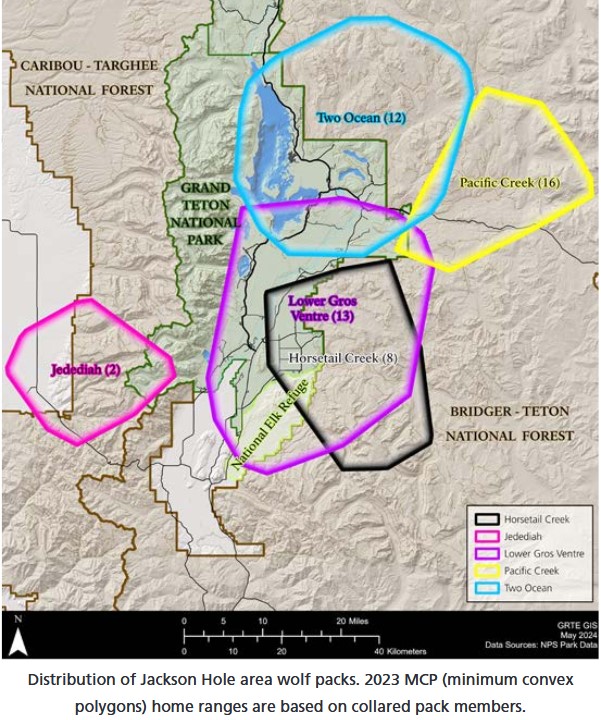
2021 wolf pack territories in and around Grand Teton National Park:
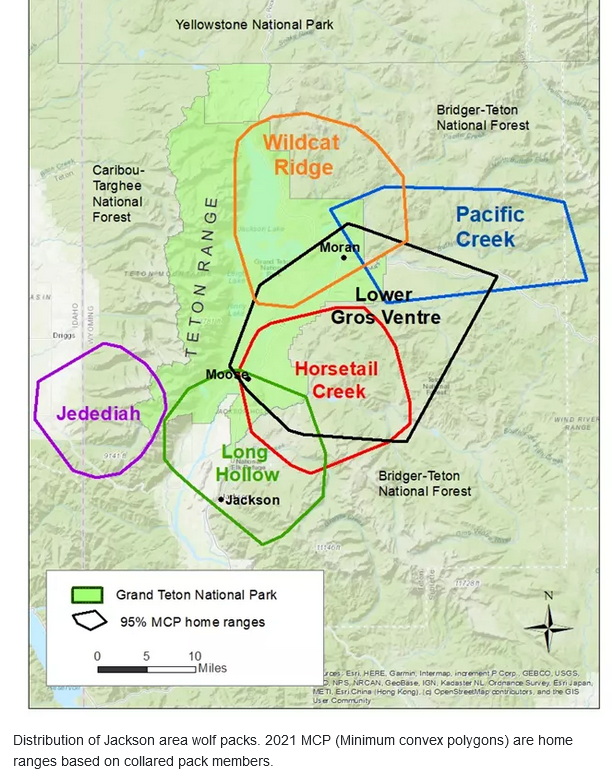
(At the end of 2021, a minimum of 43 wolves in 6 packs resided in the Jackson Hole area with home ranges in Grand Teton National Park. Jedediah (2 wolves), Horsetail Creek (10), Long Hollow (2), Lower Gros Ventre (13), Pacific Creek (12), and Wildcat Ridge (4) packs all had home ranges that included the park. Lower Gros Ventre (6 pups) and Wildcat Ridge (3 pups) denned in the park, and managers implemented closures around their den and rendezvous sites to minimize human disturbance to wolves raising young. Horsetail Creek (5 pups) and Pacific Creek (5 pups) denned outside the park. )
2020 wolf pack territories in Grand Teton National Park:
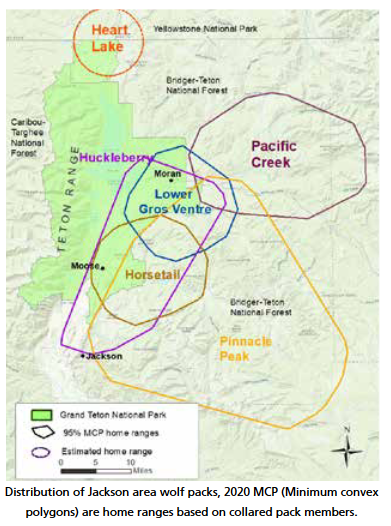
2019 wolf pack territories in Grand Teton National Park:
2018 wolf pack territories in Grand Teton National Park:
A 2017 Wyoming Game and Fish Department wolf report listed the minimum number of wolves “known to be present on Dec. 31, 2017”, in packs that reside in part or in whole in Grand Teton National Park, including 7 in the Huckleberry Pack (the purple almost circle on the map below to the right of the Teton Range), 5 in Lower Gros Ventre (the light blue colored blob below that), 11 in Pinnacle Peak ( the blue one below the Lower Gros Ventre wolf pack), 8 in Pacific Creek and 8 in Togwotee. 2017 Yellowstone wolf pack minimum size pack totals were 97 and the Wind River Reservation total minimum number of wolves was 12.
238 wolves, in 40 wolf packs, with 19 breeding pairs were known to be in Wyoming. In the map below you can see the wolf packs locations in Grand Teton and Yellowstone parks, as well as adjacent National Forest and private lands in 2017:
NPS map Distribution of Jackson area wolf packs, 2016 (with Grand Teton National park and Bridger-Teton National Forest to the east of the park and Caribou-Targhee National Forest to the west of the park)
NPS map Distribution of Jackson area wolf packs, 2015 (with Grand Teton National park and Bridger-Teton National Forest to the east of the park and Caribou-Targhee National Forest to the west of the park)
NPS map Distribution of Jackson area wolf packs, 2014 (with Grand Teton National park and Bridger-Teton National Forest to the east of the park and Caribou-Targhee National Forest to the west of the park)
NPS map Distribution of Jackson area wolf packs, 2013 (with Grand Teton National park and Bridger-Teton National Forest to the east of the park and Caribou-Targhee National Forest to the west of the park)
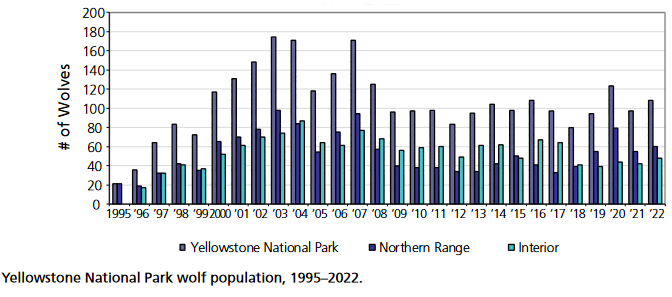
NPS chart Spatial distribution of wolf pack territory use in Yellowstone National Park over 20 years (1995-2015)
Some of the reports below say they do not have an accurate description of the territories of some of the wolf packs, because they did not have wolves in the pack wearing radio collars (GPS tracking) that the rangers put on wolves.
Below a radio collar after it finished working and dropped off the neck of the wolf:
Breeding male wolf from the Phantom Springs pack just released after being fitted with a GPS collar:
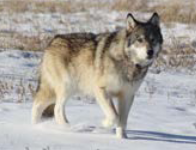
Yellowstone National Park yearly wolf reports:
2021 Wolf pack territories map:
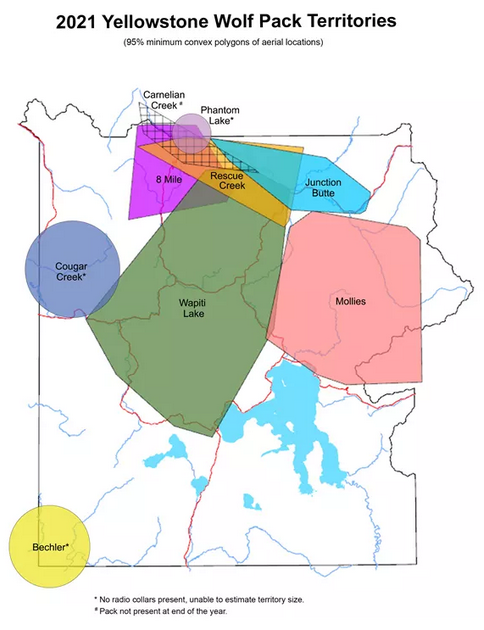
As of January 2020, in one report there were at least 123 wolves in Yellowstone park. Nine packs were noted.
2020 report:
https://www.nps.gov/yell/learn/nature/upload/FINAL-FOR-APPROVAL-WOLF-REPORT-2020_508R.pdf
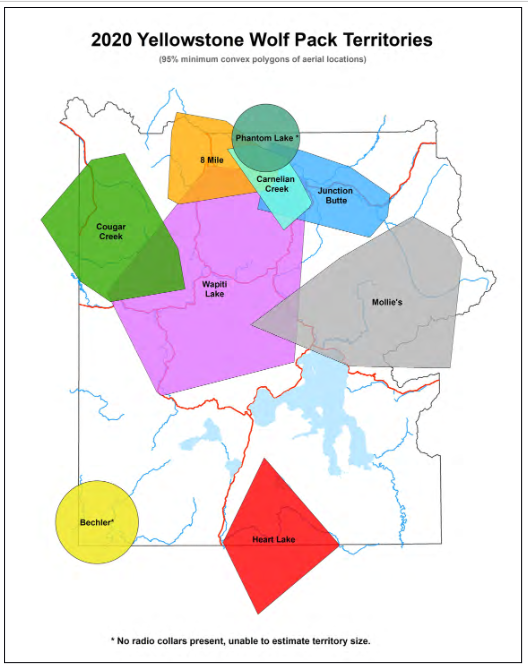
2019 report:
https://www.nps.gov/yell/learn/nature/upload/2019-WOLF-REPORT_508.pdf
2019 Yellowstone Wolf Pack Territories

2018 report:
https://www.nps.gov/yell/learn/nature/upload/2018-Wolf-Report_web-2.pdf
2017 report:
https://www.nps.gov/yell/learn/nature/upload/WOLF-REPORT-2017-YELL-FINAL.pdf
2016 report:
https://www.nps.gov/yell/upload/Wolf_Report_2016.pdf
2016 Yellowstone Wolf Pack Territories

2015 report:
https://www.nps.gov/yell/upload/WOLF-REPORT-2015-WEB-_R.PDF
2014 report:
https://www.nps.gov/yell/learn/nature/upload/2014-wolf-report.pdf
2014 Yellowstone Wolf Pack Territories
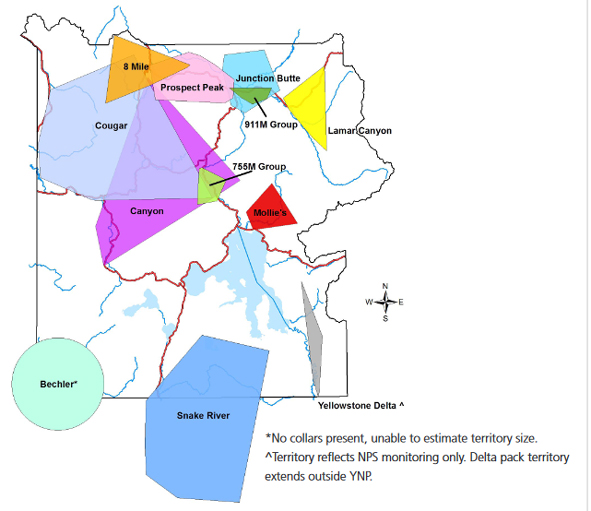
2013 report:
https://www.nps.gov/yell/learn/nature/upload/2013-Wolf-Report-Accessible_web.pdf
2012 report:
https://www.nps.gov/yell/learn/nature/upload/wolf_ar_2012_final.pdf
2012 Yellowstone Wolf Pack Territories
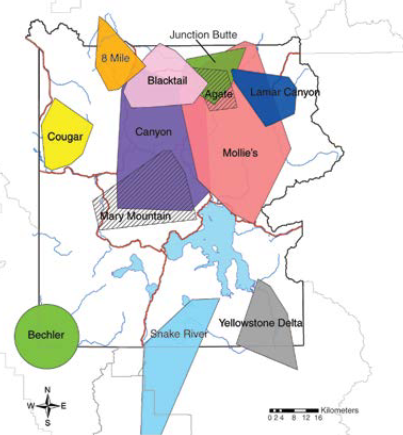
2011 report:
https://www.nps.gov/yell/learn/nature/upload/Wolf_AR_2011.pdf
2011 Yellowstone Wolf Pack Territories
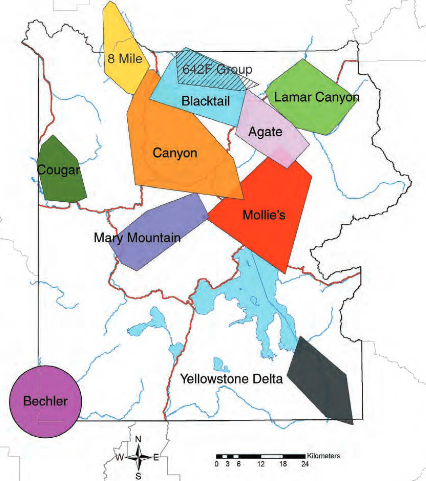
2010 report:
https://www.nps.gov/yell/learn/nature/upload/wolf_ar_2010.pdf
2009 report:
https://www.nps.gov/yell/learn/nature/upload/wolf_ar_2009_final.pdf
2009 Yellowstone Wolf Pack Territories
2008 report:
https://www.nps.gov/yell/learn/nature/upload/wolf-ar-2008.pdf
2008 Yellowstone Wolf Pack Territories
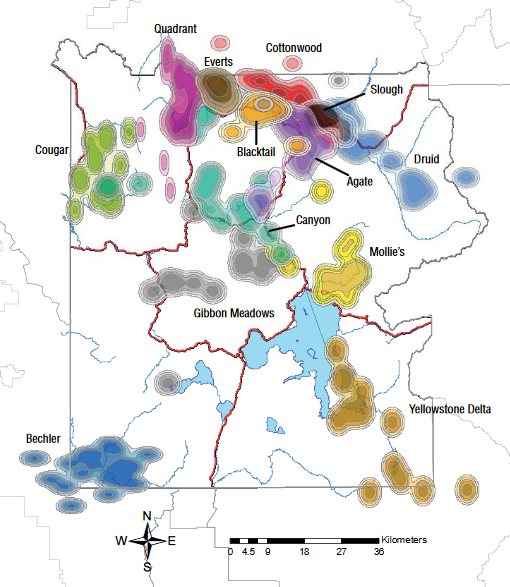
2007 report:
https://www.nps.gov/yell/learn/nature/upload/2007__Wolf_AR.pdf
2007 Yellowstone Wolf Pack Territories Darker colors depict higher use or core territories
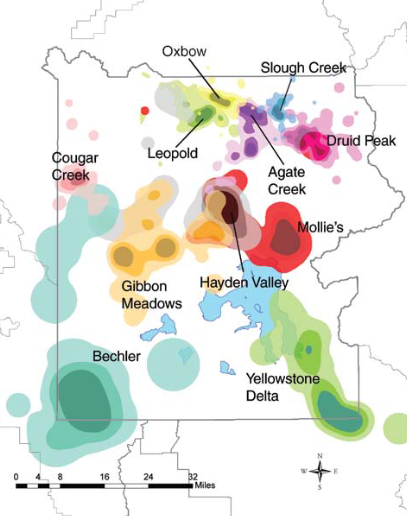
2006 report:
https://www.nps.gov/yell/learn/nature/upload/wolfrpt06.pdf
2006 Yellowstone Wolf Pack Territories Darker colors depict higher use or core territories
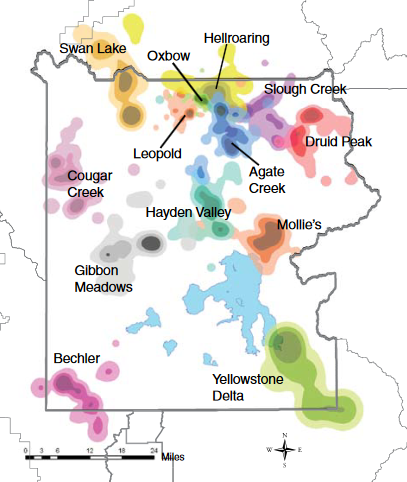
2005 report:
https://www.nps.gov/yell/learn/nature/upload/wolfrpt05.pdf
2005 Yellowstone Wolf Pack Territories
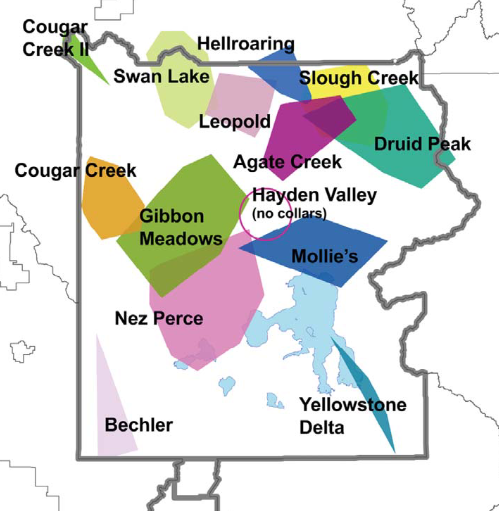
2004 report:
https://www.nps.gov/yell/learn/nature/upload/wolfrpt04.pdf
2004 Yellowstone Wolf Pack Territories
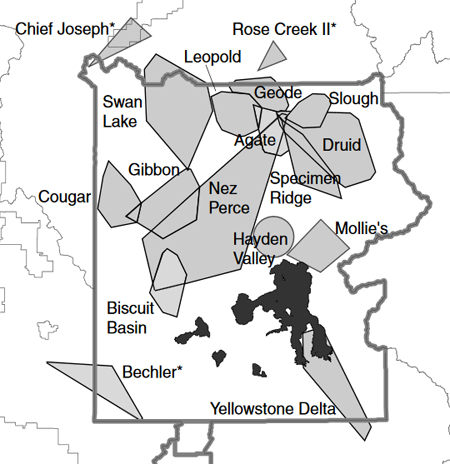
2003 report:
https://www.nps.gov/yell/learn/nature/upload/wolfrpt03.pdf
2002 report:
https://www.nps.gov/yell/learn/nature/upload/wolfrpt02.pdf
NPS map Greater Yellowstone Area Wolf Pack Territories 2002 includes Yellowstone and Grand Teton National parks. Outlines of the boundaries of each park are on the map:
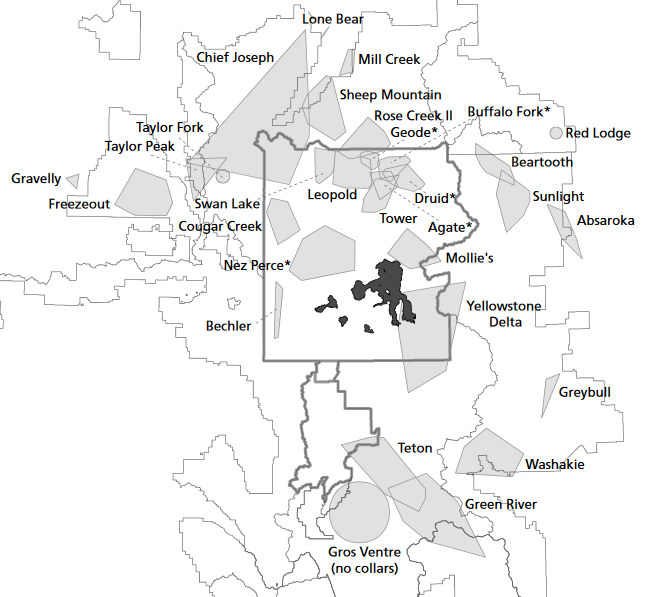
2001 report:
https://www.nps.gov/yell/learn/nature/upload/wolfrpt01.pdf
NPS map Greater Yellowstone Area Wolf Pack Territories 2001 includes Yellowstone and Grand Teton National parks. Outlines of the boundaries of each park are on the map. (At least 218 wolves—25 packs and 4 wolves without established territories—occupied the greater Yellowstone area in 2001.)
2000 report:
https://www.nps.gov/yell/learn/nature/upload/Wolfrpt00.pdf
NPS map Greater Yellowstone Area Wolf Pack Territories 2000 includes Yellowstone and Grand Teton National parks. Outlines of the boundaries of each park are on the map. (At least 177 wolves—18 packs and 2 wolves without established territories—occupied the GYA in 2000._
1999 report:
https://www.nps.gov/yell/learn/nature/upload/wolf99.pdf
NPS map Greater Yellowstone Area Wolf Pack Territories 1999 includes Yellowstone and Grand Teton National parks. Outlines of the boundaries of each park are on the map. (A total of 118 wolves—11 packs and 17 wolves without established territories—occupied the Greater Yellowstone Area in 1999.)
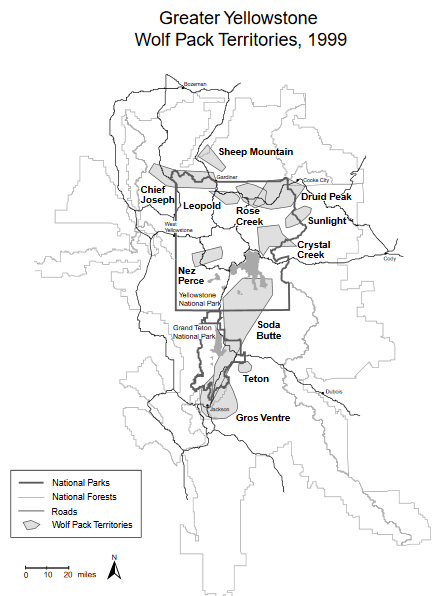
1998 report:
https://www.nps.gov/yell/learn/nature/upload/wolfar98.pdf
NPS map Greater Yellowstone Area Wolf Pack Territories 1999 includes Yellowstone and Grand Teton National parks. Outlines of the boundaries of each park are on the map. (Eleven groups including ten packs with a total of 112 wolves occupied the Greater Yellowstone Area in 1998.)
1997 report:
https://www.nps.gov/yell/learn/nature/upload/wolf97.pdf
NPS map with “Nine groups of wolves including seven packs and several loners for a total of 86 wolves occupied the Greater Yellowstone Area at the end of 1997”
1995 – 1996 report:
https://www.nps.gov/yell/learn/nature/upload/wolfrep95-96.pdf
1996 Yellowstone Wolf Pack Territories
___________________________________
Grand Teton National Park birds has photos and details about the most common ones we can hope to see
including Bald Eagle, Red-winged Blackbird, Canada Geese, Clark’s Nutcracker, Golden Eagle, Great Blue Heron.Great Gray Owl, Harlequin duck, Loon, Magpie, Merganser, Northern Flicker (woodpecker), Osprey, Ouzel, Pelican, Peregrine Falcon, Ptarmigan, Raven, Sandhill Cranes, Steller’s Jays, Trumpeter Swan, Western Meadowlark and Western Tanager, with links to calls / songs from most of them to listen to.
and you can Download photos of over a hundred birds of Grand Teton National Park
https://www.audubon.org/climate/national-parks/grand-teton-national-park
___________________________________
For actual incidents of injuries from animals, usually caused by approaching them too closely, go to: fatal, near fatal or close call incidents/accidents in camping, backpacking, climbing and mountaineering
Look for the BEARS, MOUNTAIN LION, BISON, ELK and MOOSE sections.
Top reasons not to speed in a National Park
How to not collide with a deer,
Prepare for winter driving has a link to bad weather driving tips, tips for using tire chains, tricks for dealing with frozen car locks, how to prepare your vehicle for winter driving, how to de-fog the windows, a winter survival kit for your car and what to do if you get stranded
Road trip advice and etiquette has ideas for limiting boredom, getting along on a road trip and some packing and safety tips.
fatal, near fatal or close call incidents/accidents in camping, backpacking, climbing and mountaineering is a collection of some of the true stories I use in my wilderness first aid class to illustrate how the wilderness is not dangerous, it’s the people who aren’t prepared, who don’t know what they are doing, or who take inordinate risks, that are the danger.
Cell phones in the wilderness has advice on how/when to use a cell phone to contact 911 in the wilderness and a warning about interference between cell phones, iPods and avalanche beacons.
![]() Thunderstorm and lightning safety includes a warning about not using your cell phone or IPod during a storm.
Thunderstorm and lightning safety includes a warning about not using your cell phone or IPod during a storm.
The use of cell phones for photography (with or without a selfie stick) has made preventable injury or even death by selfie common They were just taking a selfie . . .
your safety in grizzly bear territory tells you what to do if you see a grizzly in the distance or if a bear charges you and has info about Bear Pepper Sprays.
Before a bison charges What people were doing before a bison charged them, and injuries they received.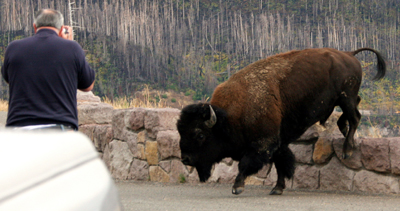
animal sign comparisons
(how to use tracks and scat to distinguish species)
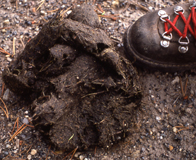
Please do not handle scat. Wolf scat, for example, can transmit tapeworm eggs to humans.
 Was that a black bear or a grizzly, a coyote or a wolf or a fox we just saw?
Was that a black bear or a grizzly, a coyote or a wolf or a fox we just saw?
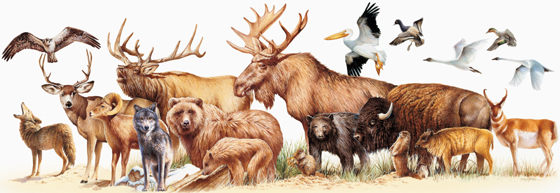 Rocky Mountain mammal size comparisons has photos and comparisons of beavers, squirrels, pika, marmot, elk, moose, bison, fox, coyote, wolf, golden-mantled ground squirrel, chipmunk, Red Squirrel (also known as) Chickaree, Unita Ground squirrels, bobcat, lynx, mountain lion (cougar), pine marten, mountain goats, bighorn sheep, pronghorn, grizzly and black bears, tundra swan, trumpeter swan, adult and juvenile Bald Eagles.
Rocky Mountain mammal size comparisons has photos and comparisons of beavers, squirrels, pika, marmot, elk, moose, bison, fox, coyote, wolf, golden-mantled ground squirrel, chipmunk, Red Squirrel (also known as) Chickaree, Unita Ground squirrels, bobcat, lynx, mountain lion (cougar), pine marten, mountain goats, bighorn sheep, pronghorn, grizzly and black bears, tundra swan, trumpeter swan, adult and juvenile Bald Eagles.
Recommended reading
Yellowstone Grizzly Bears: Ecology and Conservation of an Icon of Wildness
” . . . Bears can see in color, can hear in the ultrasonic range, and possess an incredible sense of smell.. . Heaviest Known Body Mass in the Greater Yellowstone Ecosystem: Adult male 715 pounds (324 kilograms); Adult female 436 pounds (198 kilograms)
Speed: 35 to 40 miles per hour (56 to 64 kilometers per hour)
Strength: 2.5 to 5 times greater than humans
. . . 1944: Olaus Murie . . . experimented with electric cattle prods to teach bears to avoid campgrounds, but concluded “the bear learns to recognize the particular person or car that administers the shock or other punishment, and simply avoids that person or car in the future, but does not fear other persons or cars.”
$39.95 or a free download https://www.nps.gov/yell/learn/nature/upload/Yellowstone_Grizzlies_Web.pdf
This warning from Canada can apply to any long distance drive: “Visitors to large cities and popular tourist destinations should be aware that parked cars are regularly targeted for opportunistic smash-and-grab thefts, and they are cautioned to avoid leaving any unattended possessions in a vehicle, even in the trunk. Due to the high incidence of such crimes, motorists in Montreal, Toronto, Vancouver and some other jurisdictions can be fined for leaving their car doors unlocked or for leaving valuables in view. Visitors should exercise precaution to safeguard their property.”
Yosemite National Park regulations, policies and rules are much the same as other national parks, see theselinks
Parking and traffic jams in Yosemite valley tips and tricks
——————————————————————-
The author of this webpage, (written as a reading assignment for my students), does not give any warranty, expressed or implied, nor assume any legal liability or responsibility for the accuracy, completeness, or usefulness of any information, product, or process included in this website or at websites linked to or from it. Users of information from this website assume all liability arising from such use.
